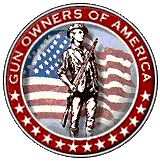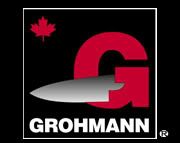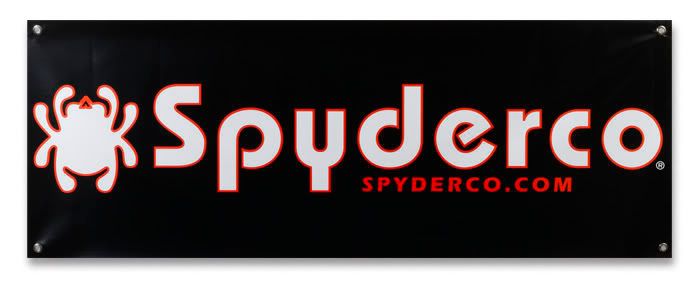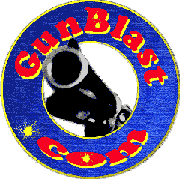#10. You can trade an old 44 for a new 22.
#9. You can keep one gun at home and have another for when you're on the road.
#8. If you admire a friend's gun and tell him so, he will probably let you try it out a few times.
#7. Your primary gun doesn't mind if you keep another gun for a backup.
#6. Your gun will stay with you even if you run out of ammo.
#5. A gun doesn't take up a lot of closet space.
#4. Guns function normally every day of the month.
#3. A gun doesn't ask, "Do these new grips make me look fat?"
#2. A gun doesn't mind if you go to sleep after you use it.
And the number one reason a gun is favored over a woman....
#1. YOU CAN BUY A SILENCER FOR A GUN
Wednesday, September 27, 2006
Tuesday, September 26, 2006
Amazing Archery
These folks are Korean and all I can say is cho-sum-ni-da! You've got to see this video which includes one archer making a fabulous shot. The slow motion is interesting as well because it shows how an arrow flies and why spine is so important.
The Koreans have long been known as archers. I'm glad they're still able to do this. I imagine I'd be doing that if I still lived there as gun ownership is nearly impossible.
NOTE: I apologize for the "other" content on the page. I didn't notice it at first...
The Koreans have long been known as archers. I'm glad they're still able to do this. I imagine I'd be doing that if I still lived there as gun ownership is nearly impossible.
NOTE: I apologize for the "other" content on the page. I didn't notice it at first...
Monday, September 25, 2006
LTC Jeff Cooper (USMC, Ret.) Has Died
The grand old man of practical pistol shooting, warrior in the cause of gun rights, essayist supreme has crossed over the river to rest in the shade of the trees. Our condolences to the family, we do indeed understand your personal loss.
Guns and Ammo Tribute
Guns and Ammo Tribute
Jeff Cooper, 86; Firearms Expert Set Standard for Pistol Technique
By Dennis McLellan, Times Staff Writer
October 1, 2006
Jeff Cooper, a firearms expert who formulated the widely used "modern technique of the pistol" and founded a highly regarded firearms training center in Arizona, has died. He was 86.
Cooper, an author and longtime Guns & Ammo magazine columnist who had experienced health problems in recent years, died Monday at his home near the training center on Gunsite Ranch, his family said.
A big-game hunter and retired Marine Corps lieutenant colonel, Cooper founded what was originally called the American Pistol Institute on Gunsite Ranch in the Sonora Desert just west of Paulden, Ariz., in 1976.
The training center expanded from teaching pistol techniques to covering military carbines, shotguns, submachine guns, hunting rifles and various other small arms. Now called Gunsite Academy, it boasts an estimated 40,000 graduates, including law enforcement officers, military personnel from around the world and civilians.
Cooper, who wrote several books on firearms and was one of the original writers for Guns & Ammo, sold the training center in 1992 but continued to live on the property.
"He's an icon in the field," Gunsite Academy owner Owen Mills said. "Probably, in the use of small arms, he is on par with John Browning, the inventor of modern American semiautomatic pistols."
Cooper, Mills said, "codified the use and deployment of small arms for personal defense."
Cooper's modern technique of the pistol grew out of his involvement with two groups he organized in the mid-1950s, the Bear Valley Gunslingers and the Southwest Combat Pistol League, which held matches in the Big Bear area and other locations.
"Jeff's contribution to all this was that he was able to observe what other people were doing and see what worked," said Ed Head, operations manager at Gunsite. "His particular genius was to turn it into a particular teaching methodology."
The modern technique of the pistol, which was later branched out to other small arms, features five elements, including the Weaver stance, named for Jack Weaver, a Los Angeles County sheriff's deputy who used two hands to grip the pistol, which created isometric tension to steady it, and used the gun sight.
"Before that, everybody had been hip-shooting — shooting with one hand, without the use of the sights," said Head. "It made a big difference."
The modern technique "has been widely accepted by all the law enforcement agencies in the world," including the Los Angeles Police Department, Mills said. "The man's probably responsible for keeping more soldiers and law enforcement officers alive than anyone in the world."
He added that Cooper's codification of firearm safety rules is "universally accepted."
Cooper, said Wiley Clapp, former handgun editor for Guns & Ammo, "has been referred to as the father of modern handgunning — accurately, I think. He is the guy who developed the technique of using a handgun defensively, the technique that is almost universal in both police and military circles and civilian circles.
"If you go to the movies and see Tom Cruise fighting his way through the bad guys … in the way they hold the pistol, the way they fire multiple shots, all of that is a somewhat Hollywood-ized version of the modern technique. The position they're generally in is a Weaver.
"So this thing that one ultra-conservative, right-wing retired colonel started in the mountains of Big Bear is so permeated in our culture that they're using it in the movies and so forth."
John Dean "Jeff" Cooper was born in Los Angeles on May 20, 1920. As a Marine during World War II, he served on the battleship Pennsylvania and later conducted what he described as "clandestine services" during the Korean War.
Cooper, who was discharged from the Marines in 1955, earned a bachelor's degree in political science from Stanford University and a master's degree in history from UC Riverside. From the late 1950s through the early '70s, he taught history part time through a community college and at the high school in Big Bear.
His books include "Cooper on Handguns," "The Art of the Rifle," "To Ride, Shoot Straight and Speak the Truth," "Sports Car Annual," two volumes of "Gunsite Gossip," "Fireworks" (a collection of essays) and the memoirs "Another Country" and "C Stories."
After Mills bought the center from another owner in 1999, Cooper returned to teach master's classes, quitting for health reasons in 2003.
His column continued to appear in Guns & Ammo, however, and he also continued to meet with Gunsite students who would visit after classes on Friday afternoons.
He'd greet them in his spacious, high-ceilinged living room, whose walls are adorned with game heads, swords and other military artifacts. Then he'd take them to his downstairs armory, where he'd hold forth on guns, politics and other topics.
Cooper, who served as the first president of the International Practical Shooting Confederation, also served on the National Rifle Assn. board of directors. In 1995, he received the Outstanding American Handgunner Award.
Cooper is survived by his wife of 64 years, Janelle; three daughters, Christy Hastings, Parry Heath and Lindy Wisdom; five grandchildren; and five great-grandchildren.
I've done it again...
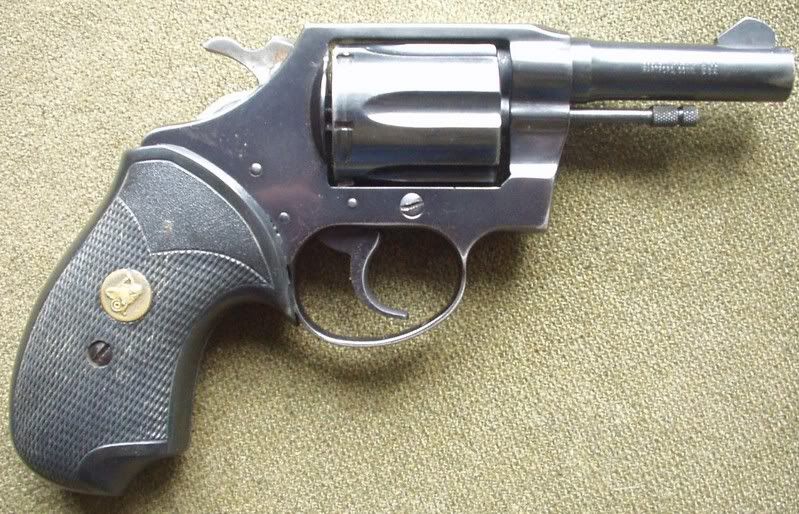 I've bought yet another revolver. This is the aforementioned 3" Detective Special, a B series it was produced in 1972. I like it. It locks up tight and the timing appears to be very good. Will try it out this afternoon!
I've bought yet another revolver. This is the aforementioned 3" Detective Special, a B series it was produced in 1972. I like it. It locks up tight and the timing appears to be very good. Will try it out this afternoon!Of course the Pachmayrs have got to go. They are not pleasing and don't suit me at all although they are very much like those for the J-frame S&Ws. This gun has the later short square butt and I think that I'd like it with the factory wood or even short, even with the butt grips. Maybe a Tyler-T grip adapter (a size 5 I believe). The sights are easy to see and the exposed ejection rod will likely not be a problem for me as I've no intention of pistol whipping anyone. Personally, I like the retro look.
 The photo to the right shows the gun, grips removed, to illustrate the grip style that became standard in, I think, 1966. I'm looking for factory wood and a Tyler-T for this gun. If you can help, drop me an e-mail.
The photo to the right shows the gun, grips removed, to illustrate the grip style that became standard in, I think, 1966. I'm looking for factory wood and a Tyler-T for this gun. If you can help, drop me an e-mail.I've never owned a Colt DA revolver and debated between this one and an Official Police, E frame I think, with 6" heavy barrel. That particular gun is timed perfectly and locks up solid. Consequentally of never owning a Colt, I don't know much about them, although I'm learning, and realizing my ignorance asked for recommendations for reference books. "Doc" O'Meara was kind enough to recommend 3 books for my edification and they are:
- "Colt Firearms" by James Serven
- "A History of the Colt Revolver" by Charles Haven and Frank Belden
- "The Book of Colt Firearms" by R. L. Wilson
I've ordered the first two, used, from two different booksellers for the munificent sum of $47 total, including shipping, however, the last is priced no less than $438! I'm sorry, but that isn't exactly going to happen for me!!! Can't wait until they come in. Lots of good reading I imagine.
Meanwhile, the search for factory wood grips will continue, and I will enjoy the revolver while I can.
Saturday, September 23, 2006
Recipes
I have only one recipe for meat. Works for any remotely palatable meat (that doesn't make you puke) and works for guests because they can't see what it might have been.
Remove all fat and cut any sort of meat into small cubes, bite size or slightly smaller. Sprinkle with garlic powder and/or black pepper to taste. Marinate in soy sauce. Pour small amount of sesame oil in fry pan or wok. Stir fry meat (with vegetables if you must) and serve over steamed rice.
If the meat is extremely tough, just cut the cubes smaller so that chewing the meat isn't really necessary.
Remove all fat and cut any sort of meat into small cubes, bite size or slightly smaller. Sprinkle with garlic powder and/or black pepper to taste. Marinate in soy sauce. Pour small amount of sesame oil in fry pan or wok. Stir fry meat (with vegetables if you must) and serve over steamed rice.
If the meat is extremely tough, just cut the cubes smaller so that chewing the meat isn't really necessary.
Friday, September 22, 2006
Detective Special - a Short History
I stole this short history of the Colt Detective Special from dfariswheel at The High Road forums. Many thanks to the author for a concise explanation.
The Colt Detective Special started off life in 1908 as the Colt Police Positive Special. In 1927, Colt fitted the PPS with a 2" barrel, named it the Detective Special and history was made.
The Detective Special became just that: the chosen pistol of detectives, undercovers, off duty cops, and anyone wanting a powerful, concealable gun. The DS was so popular, few police carried any other small gun. S&W didn't even bother making a competing model until the Chief's Special of 1950.
The "generations" of the DS depends on what your definition of generation IS.
As example, the very earliest DS's had square butts. In the early 1930's Colt changed it to the famous round butt. Is the square butt a different generation than the round butt.?
Most people follow this format:
First Generation.
Made from 1927 to the early 1950's. This model has a full profile steel grip frame, the 2" "skinny" barrel, and a slightly shorter ejector rod. Grips are checkered walnut with Silver medallions, and fit flush with the frame all the way around.
Second Generation.
In the early 1950's Colt introduced the aluminum frame Cobra and Agent. The Agent had a short "stubby" grip frame to save even more weight.
In the 1960's, Colt changed all their "D" frame revolvers to the same short frame design to simplify production. This new generation DS had the short butt, with checkered walnut grips that followed the grip frame on the front and back, but overlapped on the bottom to provide a full sized grip. Early grips still had Silver medallions, later grips were Gold. The ejector rod was lengthened.
Third Generation.
In 1972 Colt redesigned the DS to add a heavy weight barrel with a shroud over the ejector. The front sight was changed to a long ramp design. The grips were changed to a wrap-around "combat" design which left the back-strap open, but filled the front of the grip in. The grips had checkered panels, but no medallions. This was the first DS to be rated for +P ammo.
"Fourth Generation".
There really is no Fourth Gen DS since all later DS's were simple the Third Gen design with different types of grips, depending on when made. It was during the 1990's that Colt began a wild pattern of introducing models discontinuing them, then re-introducing them in a bewildering swirl. The DS was discontinued, several years later new DS's were produced from spare parts, the gun was again discontinued, then re-introduced and made from new-production parts.
Finally, in the late 1990's, the Colt Detective Special was discontinued for the last time, and replaced by a new model gun made with an entirely new action featuring a transfer-bar system. This gun was built of stainless steel, and was called the "SF" frame. Guns in this series were the SF-VI, the DS-II and the Magnum Carry.
The only original Detective Special model that was factory-authorized for +P ammunition was the post-1972 heavy shrouded barrel guns. Early versions rated the gun for "up to" 3000 rounds of +P ammo, at which point the gun was to be returned to the factory for inspection, and "possible frame replacement".
Later, in the 1990's the standard was changed to "factory inspection every 2000 to 3000 rounds".
From the standpoint of collecting, the pre-war DS is most desirable. For a shooter, the post-1972 shrouded barrel models are the best, due to better strength.
The Colt DS was offered in a variety of finishes running from the standard blue and bright nickel, to later finishes like Electroless nickel, also known as Coltguard.
Barrel lengths were 2" and 3". There were some DS's made in the 1990's that had double action-only spurless hammers, front sight inserts, and Zebra wood grips.
Like all Colt's the Detective Special could be special ordered with about any custom features the buyer was willing to pay for, but production guns varied very little.
And from Jim Keenan, the various Colt letter designations of their frame sizes...
AA - King Cobra (new action)
D - Detective Special, Cobra, Agent, Commando,
Diamondback, Police Positive, Viper
DA - Double Action .45
E - Army Special, Officers Model Match, Officers Model Target,
Official Police (old)
F - Reproduction percussion revolvers as a group
G - .22 Peacemaker, .22 New Frontier
I - Python, Trooper (old), .357 Magnum
J - Lawman Mk III and V, Official Police Mk III, Peacekeeper,
Metropolitan Mk III, Trooper Mk III and V, King Cobra
K - Frontier Scout 1962 (new)
MM - Anaconda
O - Government Model
P - Single Action Army
Q - .22 Frontier Scout, .22 Buntline Scout (old)
S - Postwar Woodsman
SF-VI - Detective Special, 1993 model
V - Short action version of the D frame
For those interested, Massad Ayoob has a short article about the Detective Special in the Nov/Dec 2006 issue of American Handgunner.
The Colt Detective Special started off life in 1908 as the Colt Police Positive Special. In 1927, Colt fitted the PPS with a 2" barrel, named it the Detective Special and history was made.
The Detective Special became just that: the chosen pistol of detectives, undercovers, off duty cops, and anyone wanting a powerful, concealable gun. The DS was so popular, few police carried any other small gun. S&W didn't even bother making a competing model until the Chief's Special of 1950.
The "generations" of the DS depends on what your definition of generation IS.
As example, the very earliest DS's had square butts. In the early 1930's Colt changed it to the famous round butt. Is the square butt a different generation than the round butt.?
Most people follow this format:
First Generation.
Made from 1927 to the early 1950's. This model has a full profile steel grip frame, the 2" "skinny" barrel, and a slightly shorter ejector rod. Grips are checkered walnut with Silver medallions, and fit flush with the frame all the way around.
Second Generation.
In the early 1950's Colt introduced the aluminum frame Cobra and Agent. The Agent had a short "stubby" grip frame to save even more weight.
In the 1960's, Colt changed all their "D" frame revolvers to the same short frame design to simplify production. This new generation DS had the short butt, with checkered walnut grips that followed the grip frame on the front and back, but overlapped on the bottom to provide a full sized grip. Early grips still had Silver medallions, later grips were Gold. The ejector rod was lengthened.
Third Generation.
In 1972 Colt redesigned the DS to add a heavy weight barrel with a shroud over the ejector. The front sight was changed to a long ramp design. The grips were changed to a wrap-around "combat" design which left the back-strap open, but filled the front of the grip in. The grips had checkered panels, but no medallions. This was the first DS to be rated for +P ammo.
"Fourth Generation".
There really is no Fourth Gen DS since all later DS's were simple the Third Gen design with different types of grips, depending on when made. It was during the 1990's that Colt began a wild pattern of introducing models discontinuing them, then re-introducing them in a bewildering swirl. The DS was discontinued, several years later new DS's were produced from spare parts, the gun was again discontinued, then re-introduced and made from new-production parts.
Finally, in the late 1990's, the Colt Detective Special was discontinued for the last time, and replaced by a new model gun made with an entirely new action featuring a transfer-bar system. This gun was built of stainless steel, and was called the "SF" frame. Guns in this series were the SF-VI, the DS-II and the Magnum Carry.
The only original Detective Special model that was factory-authorized for +P ammunition was the post-1972 heavy shrouded barrel guns. Early versions rated the gun for "up to" 3000 rounds of +P ammo, at which point the gun was to be returned to the factory for inspection, and "possible frame replacement".
Later, in the 1990's the standard was changed to "factory inspection every 2000 to 3000 rounds".
From the standpoint of collecting, the pre-war DS is most desirable. For a shooter, the post-1972 shrouded barrel models are the best, due to better strength.
The Colt DS was offered in a variety of finishes running from the standard blue and bright nickel, to later finishes like Electroless nickel, also known as Coltguard.
Barrel lengths were 2" and 3". There were some DS's made in the 1990's that had double action-only spurless hammers, front sight inserts, and Zebra wood grips.
Like all Colt's the Detective Special could be special ordered with about any custom features the buyer was willing to pay for, but production guns varied very little.
And from Jim Keenan, the various Colt letter designations of their frame sizes...
AA - King Cobra (new action)
D - Detective Special, Cobra, Agent, Commando,
Diamondback, Police Positive, Viper
DA - Double Action .45
E - Army Special, Officers Model Match, Officers Model Target,
Official Police (old)
F - Reproduction percussion revolvers as a group
G - .22 Peacemaker, .22 New Frontier
I - Python, Trooper (old), .357 Magnum
J - Lawman Mk III and V, Official Police Mk III, Peacekeeper,
Metropolitan Mk III, Trooper Mk III and V, King Cobra
K - Frontier Scout 1962 (new)
MM - Anaconda
O - Government Model
P - Single Action Army
Q - .22 Frontier Scout, .22 Buntline Scout (old)
S - Postwar Woodsman
SF-VI - Detective Special, 1993 model
V - Short action version of the D frame
For those interested, Massad Ayoob has a short article about the Detective Special in the Nov/Dec 2006 issue of American Handgunner.
This Monkey Loves a good Ride
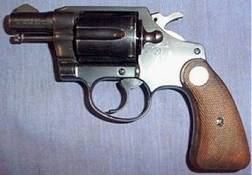 On my back that is! My recent acquisition of the S&W 34-1 and installation of the Tyler-T grip adapter has only whetted my appetite for snub guns. Yesterday, I was in my local
On my back that is! My recent acquisition of the S&W 34-1 and installation of the Tyler-T grip adapter has only whetted my appetite for snub guns. Yesterday, I was in my local (note: the illustration is of a 2" gun.)
The gun I'm considering is: a 2nd generation, a 3" barrel, blue, 85-90% finish, Pachmayr grips, square butt (I took the grips off to look), timing and lockup are excellent. Price is $320 cash which would make it $338 out the door here.
Goose Hunting
 Goose season, Canadas, is September to September. In Virginia you need a state waterfowl stamp as well as the federal migratory bird stamp.
Goose season, Canadas, is September to September. In Virginia you need a state waterfowl stamp as well as the federal migratory bird stamp.Being raised in WV, KY and VA mountains we just didn't seem to have the opportunities to duck and/or goose hunt that others seem to have. At least not enough that my dad would pop for the licenses to take me...
Now, there are large resident populations. Good size flocks/flights go over my house nightly and we see them in many fields hereabouts. Unfortunately getting permission to hunt in a field coincidental with geese is difficult. I've been in fields next to fields with geese, yes camoed up, and they will go in and out the other side. So in two years of attempts, no geese, not even a shot at a goose.
It doesn't do anything for my self-esteem that every morning I awake as my wife heads down the stairs, go to the can and am greeted by a large flight of Canadas going about 25 yards above my home making a sound that could wake the dead. Unfortunate indeed that I can't take up a position in the huge forsythia hedge in my front yard and bust my limit as they buzz my home. All the worse that I can't gain access to any field in which I've found geese even though I am using so much gas in searching for such a field that Exxon will be able to pay a record dividend this quarter. Oh well. It is fun and they are great birds.
Monday, September 18, 2006
The J-frame "Banana" and the S&W 34-1
 Shown is my new-to-me S&W 34-1 with the factory "banana" grips. These grips were purchased from CDNN Investments and are blems. On these grips there is a bit chipped on the right grip near the trigger. Not a big thing to modify the grips and refinish to remove the blem and the price was a huge $14.99. These are very comfortable grips and provide a grip similar to that when using the Tyler-T grip adapter.
Shown is my new-to-me S&W 34-1 with the factory "banana" grips. These grips were purchased from CDNN Investments and are blems. On these grips there is a bit chipped on the right grip near the trigger. Not a big thing to modify the grips and refinish to remove the blem and the price was a huge $14.99. These are very comfortable grips and provide a grip similar to that when using the Tyler-T grip adapter.What I don't like about them, and why they aren't on the gun as I type this, is that these grips extend beyond the revolver grip frame. Additional bulk. I'm trying to avoid that. So, I've been thinking of cutting these off short but even with the grip frame. Unfortunately, there is a bit of a gap, inside around the butt. If I cut them off there would be a gap between the front of the grip frame and the inside of the grips. I could glass bed these eliminating the gap... I can see this being more work than is cost effective.
For what its worth, I have ordered 2 Tyler-T grip adapters. Takes them a bit to deliver despite the fact that they have the adapters on hand and charge your card immediately. It took so long for them to deliver the first order of one that I called thinking they'd lost the order (mailed because I couldn't get them on the phone). Then I thought they might just be able to modify the order and send both adapters for one shipping price ($7+). Not so. Now I'm waiting to see if they arrive in the same package.
I've seen these at yard sales, but, I thought, I'll never need that. No more, I'm getting them when I can. Having extra on-hand doesn't seem such a bad idea any more.
The S&W 34-1 NICKELED is like a little jewel. I really didn't want a nickeled gun and passed this one by several times and delayed buying it solely because it was nickeled. However, when I gave in and that got it in hand I was smitten. All the more so after removing those Pachmayrs. Now it is so darn cute. Yep, I'm looking for a blued and a stainless (M63) version. I like them.
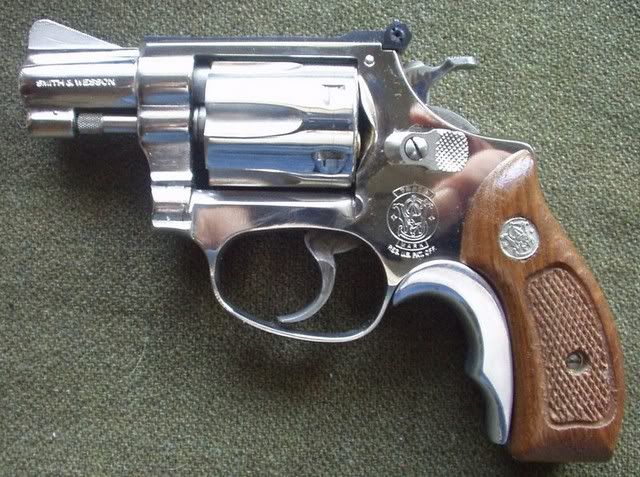 UPDATE - Well now that is interesting. I received the POLISHED Tyler-T grip adapter for the 34-1 today, but I've yet to receive the BLACK one I ordered 4 weeks ago for my M36. While Cathy (IIRC) told me there was no production delay so that I wouldn't change my order, I've yet to receive the product! One has to wonder what's up with that!
UPDATE - Well now that is interesting. I received the POLISHED Tyler-T grip adapter for the 34-1 today, but I've yet to receive the BLACK one I ordered 4 weeks ago for my M36. While Cathy (IIRC) told me there was no production delay so that I wouldn't change my order, I've yet to receive the product! One has to wonder what's up with that! FWIW, the Tyler-T on the 34-1 DOES feel almost exactly like the banana grips. Just shorter. I like it, a lot! The gun seems all business to me. If I get a M60, I'll have to get another polished Tyler-T.
Thursday, September 14, 2006
Jeff Cooper is in Poor Health - Updated
I understand that Colonel Jeff Cooper, dean of practical combat shooting, is very ill. I think prayers would be appreciated.
UPDATE
UPDATE
Update on Jeff Cooper, 14 Sep 2006Perhaps now is the time to let this great man and his family know how much we appreciate his lifetime of service to our country and to our sport.
Several months ago Jeff suffered three new fractures of his vertebrae. This has caused him severe and constant pain and he has been unable to do anything but concentrate on pain relief - this is why there have been no Commentaries since Vol. 14, No. 4, April/May, 2006.
The doctors suggested kyphoplasty, a procedure to separate the spine at the fracture sites and relieve the pain - unfortunately, this does not normally work on old fractures, or it would have been done a long time ago.
Jeff went into the hospital with the goal of getting prepped for having this procedure done, but the doctors pronounced that he is not strong enough to have it done. As it stands now, Jeff has a partially collapsed lung and has been on oxygen for several months, and additionally his heart is now showing signs of distress.
On Wednesday 13 Sept, Jeff came home from the hospital and hospice care has been arranged to assist Janelle and the family with Jeff's care. While Jeff is alert and in good spirits it is likely he will will not be out of bed much in the future. Right now everyones' focus is on keeping him as comfortable as possible.
While phone calls are not a good idea, cards and short letters for both Jeff and Janelle would be greatly appreciated. The family has asked that flowers not be sent.
You can send cards and letters to them at
Jeff Cooper
2950 W Gunsite Rd
Paulden
AZ 86334-4301
USA
Monday, September 11, 2006
The S&W 34-1


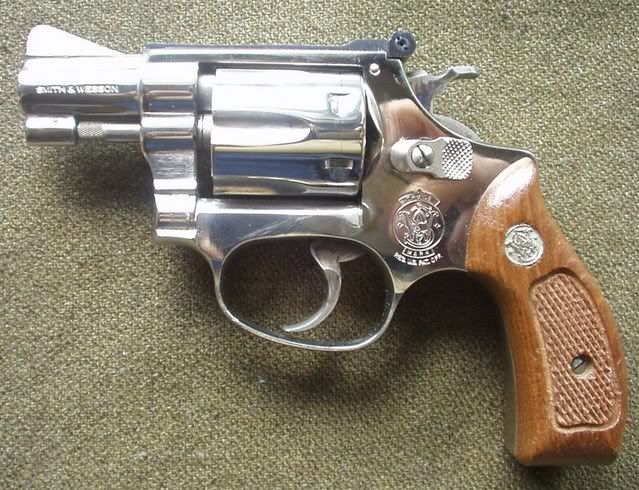
After reading the incomparable Xavier's Thoughts about the S&W 34-1 2" he had bought at a pawn shop, I had to have one. I can't say why exactly but it simply appealed to me. More than that, I became obsessed with having one. I've had several opportunities over the years and turned them all down, but now I had to have one. Of course, they are now generally priced out of this world. Recently, NIB blue guns have gone for $500+ and shooters have gone for $400+, the 63s and nickeled guns will go in the $450 range. I was most fortunate, after "settling" for a nickeled gun, to get mine for $325. Of course you have to add in shipping and transfer fees which brought it to $372. Still, that seems to be a pretty good price, all things considered. Not to worry, in 2 weeks I'll have forgotten the money and in 2 years it will be easily worth more (in case my heirs have to sell it).
I took it with me to Mom's this afternoon and with Colibris it was more than worrisome to a rampant walnut at 20 yards. A couple of cylinders full kept the errant nut rolling. Since then I've been carrying it loaded with Winchester PowerPoint but suitable test targets haven't come my way. Secured in the Simply Rugged Silver Dollar Pancake it has ridden strong side and cross draw while doing yard work including mowing about 2 acres.
I will be replacing the Pachmayrs with factory grips for now (maybe some ebony later) and a Tyler T grip adapter as I like the compactness of those grips over the Pachmayr. The only problem with the Pachmayr is the bulk. With the added bulk, I might as well carry the Single Six.
Got to shoot it some more as I passed by the range but it fouled awfully quickly. I'll clean it up and give it another go.
On that day I was out and all the ammo I had was some of that Russian Junior stuff. After a couple of cylinder's full it was very hard to rotate. Being in a rush I just went on and later cleaned the gun. Life took over and until I got DeeBee's gun the other day I hadn't had a chance to shoot it. However, I wanted to compare the two and dug up another pair of RB stocks to replace the bananas I had on it and tried it both ways.
Gee, a clean gun and it was still hard to cock a couple of chambers... Ok, stop and look. Clearly there are two chambers that are binding on the barrel face. With the fouling and not being in a rush, it was clear to see what was happening. So...
This won't do. It needs to be repaired. I get out Kuhnhausen's book. I am convinced that I don't have the tools nor the talent to fix this. I also see that some fixes might be problematic with the nickeled gun.
Friday, September 08, 2006
Archery
I've been shooting a bow since I was 8. My first bow was an all fiberglass recurve and I've loved recurves ever since.
I'd buy arrows one at a time from the hardware or wherever I could get them. If shot and "lost" I'd search for hours to recover the precious things. One or two would be a month's allowance and it took no time at all to pass over the huge sum to the store clerk for the precious fletched sticks.
Recently, a forum acquaintance asked about buying a bow from a major mail order house. He allowed as to how he had no archery experience. Well, that generated a lot of posts and mine was a doozy. I must have typed a 1000 word essay just as quick as you can recite the poem about Jack Sprat. With 42 years of experience I guess I'd learned a few things worth sharing. It is unfortunate that the post was lost, it would have saved me some typing here!
Archery is worth the effort and expense of entry. It is a joy and some of likened it to shooting basketball with a fast pointed stick BUT with a purpose. There is no purpose to basketball. Archery is a connection to our past. A long and cherished past. It is our link to thousands of years of subsistence hunting, to Agincourt and Crecy, to grandfathers and uncles beyond counting. It connects us to our roots as free men and women. But we, most of us, are not raised as archers and archery takes some effort.
If you are just beginning archery, man or boy, woman or girl, I have a few suggestions. The first of these is get a good book on the subject and read it cover to cover, at least twice. I suggest "Beginner's Guide to Traditional Archery" by Brian J. Sorrells and/or Traditional Archery by Sam Fadala. These deal with traditional archery from which it is easiest to branch out to the primitive and high-tech versions. I think that the most interesting magazines on the market are "Traditional Bowhunter" and "Primitive Archer" magazines. Of course, reading is not the be all end all of archery study, you have to shoot as well.
My recommendation for the beginning shooter is not the strongest bow you can pull/draw but a bow in the middle range for you. Given that the student is unaccustomed to the action and effort involved in drawing the bow, for most male adults that would be a bow of 45 or 50 lbs draw weight at their draw length. For women that would be 35-45 lbs draw weight and for children that would be 15-25 lbs draw weight. Remember, this is average and we are working to build the new shooter up to drawing the bow without injury NOT trying to establish records. Remember too that a 45-50 lb bow will meet the legal requirements in most states for a hunting bow.
Arrows are a matter of prejudice and personal preference. I believe the new shooter should start with as trouble free equipment as possible and so I would suggest aluminum arrows. Arrows must have the correct spine for the bow from which they are shot so you must choose the bow first. You can buy arrows cut to the correct length for you, nocked, fletched and with inserts for the points at most supply shops, by mail and over the internet. Aluminum arrows are most likely to withstand the beating to which they'll be subjected by new archers. One can always switch to cedar shafts later. I'd suggest, too, that one get a full dozen. You might consider it pricy but they are only getting more expensive and if you use only 6 with which to train and practice you'll have 6 good arrows with which to hunt later. Using 6 arrows for practice has another benefit. After loosing 6 arrows at the butt, you then have time to rest your muscles and think about what just happened as you walk down to the butt and then back to your shooting position. Properly applied this rest period can do wonders for your shooting!
The next thing you'll NEED is an armguard. This is what protects your forearm from the string. Even if you wear a shirt or jacket, this will keep the bowstring from dragging on your clothing. It should cover from just below the elbow to the wrist. New shooters tend to drag the string down the length of their arms. You will inevitably forget to don the brace once, but you're not likely to forget it twice.
You'll also need some method of releasing the bow string. A finger release almost mandates a glove or tab for most of us. Some masons can get by without and I never used one when I was shooting a 25 lb draw bow but I think it is likely preferable for most of us. Bleeding fingertips are unsightly. My suggestion is the Damascus glove. It is both durable (I'm still using the first one I bought although I've two more just in case) and secure on the hand. Many gloves or fingers aren't so secure and I don't like the tabs as they seem slow to use to me.
You will also need a target butt. We always used 3 hay bales stacked one on top of the other and pinned a paper plate to the center bale. Most field point arrows won't completely penetrate a tight bale and this was good for catching most inevitable overs as well. You can however, as with most things, get something high-tech like one of the stacked plastic sheet bales such as the Block. These don't catch the wobbles unders and overs so well though.
Well, now you're ready to start. Follow the bow's manufacturer instructions for stringing the bow. Start out very close to the target. The initial goal is to become familiar with the equipment and comfortable with the mechanics of nocking an arrow and drawing to full draw, the target is really only there to catch the arrow as you practice. BUT, do try to hit the target. Start with the butt at 5 yards (15 feet) and as you progress back off 1 yard (3 feet). Shoot until you can keep every arrow on the paper plate. After loosing a few hundred arrows you might find yourself at about 25 yards. Take a break, go inside and get a smaller paper plate, you know one of those little desert plates. Shoot at that a while. You can wait a bit before you get the foam deer dummy.
Some fun practice you an have in the field is to take a flu-flu arrow (BIG fletching) with a Judo Point and go on a short walkabout with the bow and one arrow. Shoot at stumps, cactus, cedar saplings, tin cans and other targets of opportunity. It is plinking without the expenditure of much in the way of money and it is a lot of fun. Called roving, it will get you out and about, you can even combine this with scouting for your later deer hunting.
This is what I did, sometimes in fits and starts, and I have long loved archery...
I'd buy arrows one at a time from the hardware or wherever I could get them. If shot and "lost" I'd search for hours to recover the precious things. One or two would be a month's allowance and it took no time at all to pass over the huge sum to the store clerk for the precious fletched sticks.
Recently, a forum acquaintance asked about buying a bow from a major mail order house. He allowed as to how he had no archery experience. Well, that generated a lot of posts and mine was a doozy. I must have typed a 1000 word essay just as quick as you can recite the poem about Jack Sprat. With 42 years of experience I guess I'd learned a few things worth sharing. It is unfortunate that the post was lost, it would have saved me some typing here!
Archery is worth the effort and expense of entry. It is a joy and some of likened it to shooting basketball with a fast pointed stick BUT with a purpose. There is no purpose to basketball. Archery is a connection to our past. A long and cherished past. It is our link to thousands of years of subsistence hunting, to Agincourt and Crecy, to grandfathers and uncles beyond counting. It connects us to our roots as free men and women. But we, most of us, are not raised as archers and archery takes some effort.
If you are just beginning archery, man or boy, woman or girl, I have a few suggestions. The first of these is get a good book on the subject and read it cover to cover, at least twice. I suggest "Beginner's Guide to Traditional Archery" by Brian J. Sorrells and/or Traditional Archery by Sam Fadala. These deal with traditional archery from which it is easiest to branch out to the primitive and high-tech versions. I think that the most interesting magazines on the market are "Traditional Bowhunter" and "Primitive Archer" magazines. Of course, reading is not the be all end all of archery study, you have to shoot as well.
My recommendation for the beginning shooter is not the strongest bow you can pull/draw but a bow in the middle range for you. Given that the student is unaccustomed to the action and effort involved in drawing the bow, for most male adults that would be a bow of 45 or 50 lbs draw weight at their draw length. For women that would be 35-45 lbs draw weight and for children that would be 15-25 lbs draw weight. Remember, this is average and we are working to build the new shooter up to drawing the bow without injury NOT trying to establish records. Remember too that a 45-50 lb bow will meet the legal requirements in most states for a hunting bow.
Arrows are a matter of prejudice and personal preference. I believe the new shooter should start with as trouble free equipment as possible and so I would suggest aluminum arrows. Arrows must have the correct spine for the bow from which they are shot so you must choose the bow first. You can buy arrows cut to the correct length for you, nocked, fletched and with inserts for the points at most supply shops, by mail and over the internet. Aluminum arrows are most likely to withstand the beating to which they'll be subjected by new archers. One can always switch to cedar shafts later. I'd suggest, too, that one get a full dozen. You might consider it pricy but they are only getting more expensive and if you use only 6 with which to train and practice you'll have 6 good arrows with which to hunt later. Using 6 arrows for practice has another benefit. After loosing 6 arrows at the butt, you then have time to rest your muscles and think about what just happened as you walk down to the butt and then back to your shooting position. Properly applied this rest period can do wonders for your shooting!
The next thing you'll NEED is an armguard. This is what protects your forearm from the string. Even if you wear a shirt or jacket, this will keep the bowstring from dragging on your clothing. It should cover from just below the elbow to the wrist. New shooters tend to drag the string down the length of their arms. You will inevitably forget to don the brace once, but you're not likely to forget it twice.
You'll also need some method of releasing the bow string. A finger release almost mandates a glove or tab for most of us. Some masons can get by without and I never used one when I was shooting a 25 lb draw bow but I think it is likely preferable for most of us. Bleeding fingertips are unsightly. My suggestion is the Damascus glove. It is both durable (I'm still using the first one I bought although I've two more just in case) and secure on the hand. Many gloves or fingers aren't so secure and I don't like the tabs as they seem slow to use to me.
You will also need a target butt. We always used 3 hay bales stacked one on top of the other and pinned a paper plate to the center bale. Most field point arrows won't completely penetrate a tight bale and this was good for catching most inevitable overs as well. You can however, as with most things, get something high-tech like one of the stacked plastic sheet bales such as the Block. These don't catch the wobbles unders and overs so well though.
Well, now you're ready to start. Follow the bow's manufacturer instructions for stringing the bow. Start out very close to the target. The initial goal is to become familiar with the equipment and comfortable with the mechanics of nocking an arrow and drawing to full draw, the target is really only there to catch the arrow as you practice. BUT, do try to hit the target. Start with the butt at 5 yards (15 feet) and as you progress back off 1 yard (3 feet). Shoot until you can keep every arrow on the paper plate. After loosing a few hundred arrows you might find yourself at about 25 yards. Take a break, go inside and get a smaller paper plate, you know one of those little desert plates. Shoot at that a while. You can wait a bit before you get the foam deer dummy.
Some fun practice you an have in the field is to take a flu-flu arrow (BIG fletching) with a Judo Point and go on a short walkabout with the bow and one arrow. Shoot at stumps, cactus, cedar saplings, tin cans and other targets of opportunity. It is plinking without the expenditure of much in the way of money and it is a lot of fun. Called roving, it will get you out and about, you can even combine this with scouting for your later deer hunting.
This is what I did, sometimes in fits and starts, and I have long loved archery...
Tuesday, September 05, 2006
In Memoriam - Steve Irwin
 44 year old TV star and naturalist Steve Irwin was killed by a stingray. He is survived by his parents, siblings, wife Teri, daughter Bindi Sue and son Bob. The Australian was well known as the Crocodile Hunter and his apparently over the top antics with dangerous creatures while maintaining an intensely infectious enthusiasm garnered many loyal viewers.
44 year old TV star and naturalist Steve Irwin was killed by a stingray. He is survived by his parents, siblings, wife Teri, daughter Bindi Sue and son Bob. The Australian was well known as the Crocodile Hunter and his apparently over the top antics with dangerous creatures while maintaining an intensely infectious enthusiasm garnered many loyal viewers. You might hear many jokes, fond memories, criticisms, the whole gamut of reactions. However, whatever you might think of his approach you have to admit that he got lots of people interested in the natural world. Sort of the Marlin Perkins of this generation I think his loss will be felt for a long time to come.
Sunday, September 03, 2006
The Saga of the S&W 34 Quest
That slick old Xavier posted about a S&W 34-1 2" and it ignited a craving that is without reason or rational cause. Then Lady Tam posts about her great fun with hers and so do some folks of whom I inquire about their experiences with these petite firearms. The hunger grows. Apparently I was not the only person so affected. Suddenly, you can look up old completed auctions, the prices on these guns shot up. They sold and for goodly prices. Blue, nickel, or stainless (M63) matters not. NIB or imperfect matters not. Prices rise quickly. Where I thought I could afford one, I find that I can not. Talk about discouraging. Then I find one on GunsAmerica and committ to the purchase but as it is the weekend I've no word yet and perhaps it is already sold. Frustrating indeed.
UPDATE: The nickel 34-1 should be enroute to my dealer shortly. I was outbid on another.
UPDATE: The nickel 34-1 should be enroute to my dealer shortly. I was outbid on another.
Subscribe to:
Comments (Atom)



